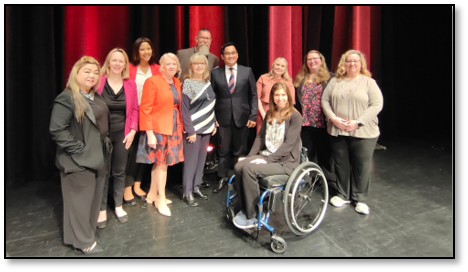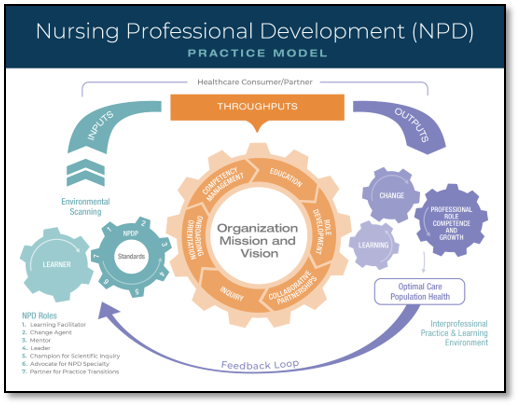
Transforming Outputs
Association News
NPD Scope and Standards, 4th Ed., Hits the Trail at Aspire to Trailblaze
By Mary Harper, PhD, RN, NPDA-BC®, and Patsy Maloney, EdD, MSN, NPD-BC, CEN, NEA-BC
Pictured from left to right:
- Joy Kiat-Floro, MBA, MSN, RN
- Cari Uland, MA, BSN, RN, NPD-BC
- Melanie Rainford, MSN, RN, NPD-BC
- Patsy Maloney, EdD, MSN, NPD-BC, CEN, NEA-BC
- Mary Harper, PhD, RN, NPDA-BC®
- Gregory J. Durkin, MEd, RN, NPDA-BC®
- Warly Remegio, DNP, RN, NPD-BC, NEA-BC
- Vanessa Cameron, MSN, RN, NPD-BC, CEN, CNL
- Stephanie Zidek, MSN, AGCNS-BC, NPD-BC, NEA-BC
- Elizabeth Fritz, PhD, RN, NPDA-BC®
- Jean Carraher, DNP, RN, NPD-BC, NE-BC, CCRN-K
On Wednesday, March 23 the Nursing Professional Development Scope and Standards Workgroup saddled up with trail leads, Mary Harper, PhD, RN, NPDA-BC® and Patsy Maloney, EdD, MSN, NPD-BC, CEN, NEA-BC, and hit the trail at the ANPD Annual Convention with Nursing Professional Development: Scope and Standards of Practice, 4th edition. Unfortunately, three trail guides were unable to join us at the convention, but their work ensured we were properly provisioned for the journey:
Pamela S. Dickerson, PhD, RN, NPDA-BC®, FAAN
Latrina (Trina) Geyer, PhD, RN, NPD-BC, NEA-BC
Zoe Youl, MN, CCRN
During a game changer session, the workgroup panel presented key updates to the 4th edition of the foundational document of our specialty practice, which delineates our scope of practice as well as the standards and competencies that we are expected to meet. While the evidence-based roles and responsibilities of the NPD practitioner were unchanged, the new document aligns closely with the Nursing: Scope and Standards of Practice (American Nurses Association [ANA], 2021). This alignment necessitated incorporation of some previous standards, such as Change Management and Consultation, into other standards.
One very popular addition to the scope and standards is the term NPD practice judgment. NPD practice judgement is the “identification and interpretation of the learner’s needs and the decision to act—or not act—on those needs using typical, modified, or innovative NPD interventions as appropriate” (Harper & Maloney, 2022). This definition is adapted from Tanner’s (2006) seminal work describing clinical practice judgment.
The NPD scope of practice, which is represented by the NPD Practice Model, has been updated to include the healthcare consumer/partner (i.e., patient) as the ultimate beneficiary of NPD initiatives, as shown in the figure below. The model has also been changed to include the NPD practitioner’s employing organization’s mission and vision as central to the NPD responsibilities depicted as the throughputs of the model. This placement emphasizes the organization’s mission and vision as the guiding principles for making decisions and setting priorities.

Recognizing that education is only one of six NPD responsibilities, the standards of practice, Standards 1–6, have been expanded to include NPD ‘initiatives’. The standards of professional performance, Standards 7–18, include new standards on advocacy, communication, and environmental health. All standards incorporate diversity, equity, and inclusion (DEI) as a primary focus in all areas of NPD practice.
During the general session at convention, Dr. Warly Remegio drew applause as he passionately described new areas of advocacy identified in the new scope and standards. These areas include advocacy for the healthcare consumer/partner, learners, colleagues, the NPD specialty, the nursing profession, and self.
In addition to the general session, the NPD Scope and Standards Workgroup hosted the networking session on Thursday. During this session, participants, under the careful watch of workgroup trail guides, considered questions pertaining to application of the new document, and reported out to the full group of about 80 NPD practitioners in attendance. The following actionable suggestions came from these lively discussions:
- The new scope and standards will be useful for succession planning, orientation, and job descriptions for NPD.
- The addition of the healthcare consumer/partner to the NPD Practice Model necessitates providing tools to learners to advocate for the patient.
- Inclusion of academic-practice partnerships in the new standards strengthens NPD’s responsibility for developing a pipeline of new healthcare professionals and facilitates alignment with the organization’s mission and vision.
- NPD departments can measure their department contributions to the organization’s mission and vision (outcomes) through retention, quality indicators, and patient satisfaction—among other things. These contributions can be communicated through dashboards and additional organizational communication channels.
- Standard 9, Respectful and Equitable Practice is met by asking individuals their preferred pronouns, assessing technology proficiency and availability, avoiding stereotypes, and communicating respectfully.
- Standards 5B, Health Teaching and Health Promotion, and Standard 18, Environmental Health normalize use of employee assistance programs (EAP), intentional rounding to assess staff well-being, and addressing/preventing workplace violence.
- NPD practice judgment promotes personal professional development and collaboration with leaders. It requires knowledge of the learner, experience, data, evidence-based practice, education, needs assessment, and defining issues. ANPD member Lametria Wafford cautioned us, “Don’t lose the whack in your smack!”
- The replacement of lifelong learning with ‘ongoing professional learning’ implies achieving results of professional development, improvement, and change.
Although the Nursing Professional Development: Scope and Standards of Practice, 4th edition, sold out at convention, more are available here. Take advantage of bulk pricing when you order 10 or more copies. Posters of the updated model, which are 16” x 20” are also available.
References
American Nurses Association. (2021). Nursing: Scope and standards of practice, 4th edition. Nursebooks.org.
Harper, M. G., & Maloney, P. (Eds.). (2022). Nursing professional development: Scope and standards of practice (4th ed.). Association for Nursing Professional Development.
Tanner, C. A. (2006). Thinking like a nurse: A research-based model of clinical judgment in nursing. Journal of Nursing Education, 45(6), 204-211. doi: 10.3928/01484834-20060601-04